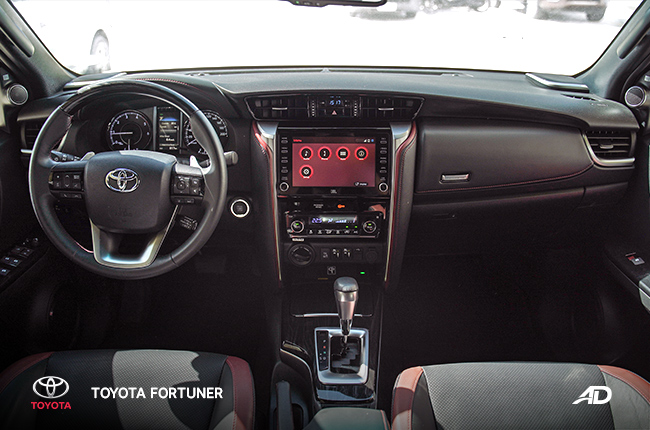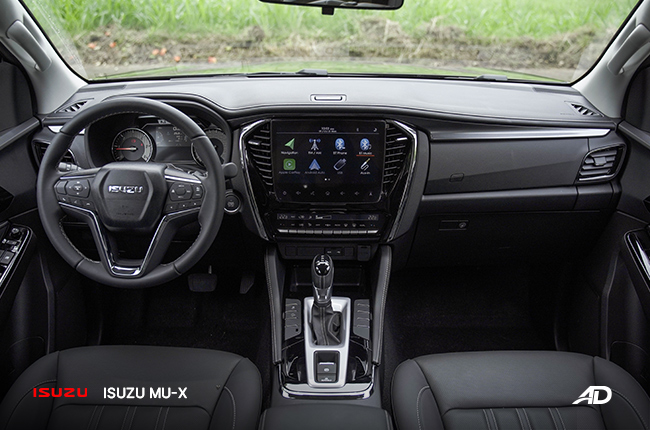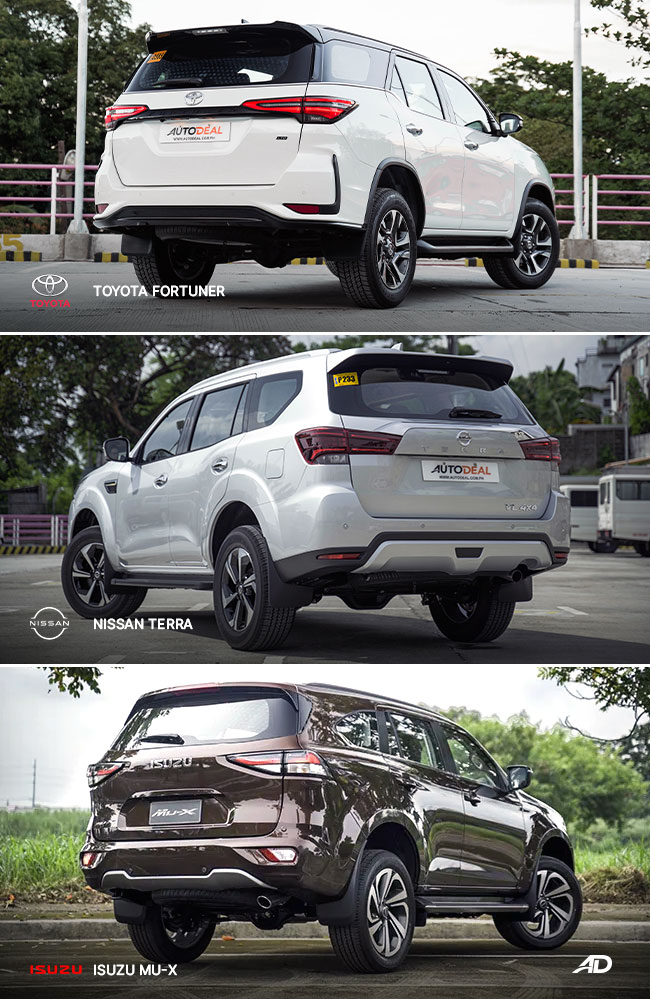
In the SUV segment in the Philippines, out of the popular choices, the Isuzu mu-X, Nissan Terra, and the Toyota Fortuner all equally stand out amongst their competition. These are the go-to models for those looking to get a feature-packed vehicle that can also double as a reliable family car. They are also the nameplates to choose if you want a tried and tested platform that you can’t go wrong with. That being said, as all of these three SUVs have gotten an update over the past year we will now compare each one in a three-way comparison, spec for spec, to see which one will come out on top.
Exterior

The designs for these SUVs have evolved due to advancements in technology. Some of these vehicles have had bolder design changes while others have retained a more stubble look. Between the three SUVs in this comparison, their respective brands have each taken different approaches on how they wanted to style their vehicles. These give customers and long-time fans of the nameplates a wider array of options to choose from.

Starting with the Toyota Fortuner, it is clear at least for the LTD model that the Japanese automaker has gone with a sportier approach to its SUV styling. You can see this in its sharper angles as well as in the sharper cuts and creases of the front fascia. This is also evident in the new bumpers, grille, as well as its new LED headlights. All together the Fortuner gives off an overall sportier design compared to its previous iteration.

Isuzu’s mu-X design is more of an evolutionary step forward rather than a more radical one. You still see the design elements of the older model, but this time around it takes on a much rounder and sleeker appearance. If the previous generation had sharper angles in its design, this one is a little bit more subdued but still manages to have an imposing stance thanks to its wide and tall fascia evident in its new bumpers, grille, and headlight designs.

The Nissan Terra, on the other hand, is similar to its Isuzu counterpart as it takes an evolutionary step forward in its design. It now sports a new version of the automaker’s V-motion design language that has given the SUV a more rugged, boxy, and more angular appearance compared to its older model. The upgrade has also given the vehicle a new set of quad-LED headlights along with a new bumper and a much larger grille than before. Minor changes have also been made to the rear and the sides of the vehicle to overall complement the front fascia. Overall it’s still a familiar design but with a few new changes that old and new customers alike will enjoy.
For this category, we will give it as a tie as each one comes with its unique designs to better suit its target audience. They are also on the same playing field when it comes to their exterior features boiling it down to personal preference as the deciding factor.
Winner: Tie
Interior
All the SUVs in this three-way comparison come with leather seats, great cargo space, and a 7-seater occupant capacity as standard for all of their top-of-the-line models. This puts them very close to one another as to what they can offer with personal preferences out of the picture for their interior designs. Their cabin configurations are also pretty similar to one another with only a few minor differences in between. Legroom and the headroom across all three SUVs are about the same as well with the 3rd row being the tightest to enter.

The updated Toyota Fortuner carries over its dashboard layout from its previous iteration but with a few splashes of color found on key parts of the interior of the SUV. Something to note is that the LTD variant now comes with maroon accents spread throughout the cabin. Moving onto the seating material and it’s still the same story as before as the vehicle has retained its soft and comfortable seats. Aside from this, the Fortuner now has Galaxy Black accents that can be found on a lot of its interior pieces as part of its latest update. With all things considered, the cabin is still a familiar space to be in making it easier to quickly know where the controls are especially if you have owned the previous version of the Fortuner.

The Isuzu mu-X makes a radical departure from its predecessor when it comes to its new interior design. The SUV now sports a more refined dashboard with sharper angles and an overall boxy design compared to its older model. Soft-touch materials are now more pronounced especially in the range-topping LS-E variants and the leather seats are still supportive and as comfortable as ever. While the mu-X still goes for a traditional black and gray themed interior, it works well with the new vehicle further indicating a push for a more luxurious look and feel.

Nissan’s Terra SUV takes a similar approach to its interior design the same way it has done with the exterior. The vehicle now gets a new dashboard that showcases a boxier and squared-off look compared to its previous model. The infotainment system has also increased in size and now has become mo prominent at the center of the dashboard. The Terra also receives a new gauge cluster along with a new flatbottom steering wheel to match the overall sportier look of the SUV. Its center console along with the shifter has also been redesigned to give off a much sleeker appearance. A new larger accent trim piece has also been added to the vehicle which now comes with soft-touch material.
For this category, we give the win to the Isuzu mu-X as it shows a more drastic change over its predecessor. It goes to show that when the Japanese automaker creates a new version of its popular SUV, it does so with longevity in mind as this new interior will surely age well as time goes on. However, it is important to note that the Nissan Terra comes in a close second as it too has seen changes to the inside and outside of the vehicle.
Winner: Isuzu mu-X
Technology
In terms of the technology that each of these SUVs packs, they are pretty evenly matched with only negligible differences between the three. They all come with Apple CarPlay and Android Auto as standard making it easier and more convenient for the user to connect their smartphones to the vehicle.

Size-wise the Isuzu mu-X comes out on top with the largest infotainment system out of the three SUVs. It comes with a 10.1-inch infotainment system that is standard for all of its variants. It also doubles as the vehicle’s reverse camera as well. Something to note is that the mu-X no longer has its rear flip-down display that was present in its predecessor. This puts it at a slight disadvantage over its other rivals.

The Nissan Terra is the second SUV to come with the biggest screen sizes available for its infotainment system. It can either be had with a 9- to 8-inch touchscreen depending on the variant you chose. The display will also double as your 360-degree camera monitor giving you a better view of what’s around the SUV. Wireless Apple CarPlay is also present in the vehicle making it more convenient for iPhone owners to sync up their smartphone to the infotainment system. Aside from this, the Terra retains its 11-inch flip-down rear display for added entertainment for the passengers at the back. One thing to note is that the Terra does not come with a power tailgate unlike the rest of its rivals.

Just like its other rivals, the Toyota Fortuner can also be had with a touchscreen infotainment system. However, it does come a few inches smaller than the Terra and mu-X. It too can be had with an 8- or 7-inch touchscreen infotainment system along with a 360-degree camera. This puts it on par with the rest in terms of functionality and connectivity. Just like its Mitsubishi rival, the Fortuner also has a power tailgate.
For this category, we award it as a tie between the Nissan Terra and the Toyota Fortuner as they both come with a 360-degree camera system that isn’t present in the mu-X. Notably, the Nissan SUV is equipped with a BOSE speaker sound system for its range-topping model along with an 11-inch flip-down display for the passengers at the back.
Winner: Tie
Power
Just like the other SUVs in this respective segment, the three vehicles that were chosen for this comparison come with powerful turbo-diesel engines at their disposal along with an array of reliable automatic and manual transmission options to choose from.

Leading the pack is the Toyota Fortuner as it comes with the most powerful engine available. Its 2.8-liter turbo diesel produces 201hp and 500 Nm of torque putting it way ahead of its other rivals in this comparison. It is important to note that not all models of the Fortuner come with this powerful motor under the hood, other variants of the vehicle come with a 2.4-liter turbo diesel that produces 148 hp and 400 Nm of torque. This puts the small displacement variants at a slight disadvantage over its other Japanese SUV rivals.

Close behind the Fortuner is the Nissan Terra as its engine produces 187hp and 450 Nm of torque. It still carries over the same 2.5-liter form factor from before along with its 7-speed automatic transmission. It also retains its 6-speed manual from its predecessor for those who like to shift gears themselves. It’s a tried and tested formula that has worked well for the SUV throughout the years.

The Isuzu mu-X rounds off this comparison by having a choice between an upgraded 3.0-liter motor or its classic 1.9-liter mill. While the 3.0-liter has received a significant increase in power as it now pushes out 187 hp and 450 Nm of torque. Its 1.9-liter variant still has the same output. With this in mind, this puts the mu-X on par with the Terra in terms of their power outputs but from a bigger displacement engine.
With that said, the winner of this category goes to the Fortuner for having the most power available from its 2.8-liter variants.
Winner: Toyota Fortuner
Safety
All the SUVs being compared are in their top-of-the-line trims. This means that they come with all the bells and whistles when it comes to their safety equipment.

For its latest update, the Toyota Fortuner now comes with Toyota Safety Sense, this has given the SUV access to a pre-collision system, a lane departure alert system, and adaptive cruise control. It also comes with standard features such as a host of airbags located in key parts of the vehicle and ABS with EBD. Other safety features for the SUV include a panoramic view camera, front and rear clearance sensors, vehicle stability control, hill start assist control, and downhill assist control.

The Isuzu mu-X has also received a generous number of upgrades when it comes to its safety features. The Japanese SUV now has access to an advanced driver-assist system that gives it features such as a blind-spot monitoring system, rear cross-traffic alert, rear parking sensors, and a reversing camera. Other features present in the mu-X include a collision warning system, autonomous emergency braking, turn to assist, pedal misapplication mitigation, adaptive cruise control, manual speed limiter, automatic high beam, multi-collision brake system.

Similar to its Toyota counterpart the Nissan Terra has also carried over much of its features from its predecessor. The SUV also now comes with the brand’s newest version of the Nissan Intelligent Mobility system that gives it access to an around-view monitor, intelligent rearview mirror, forward collision warning, intelligent emergency braking, lane departure warning, blind-spot warning, rear cross-traffic alert, intelligent driver alertness, and a tire pressure monitoring system.
For this category, we put it as a tie between the Nissan Terra and Isuzu mu-X as they both come with new features that have increased the safety factor between the two models. That being said, the Nissan SUV has a slight advantage over its Isuzu Rival as it comes with a 360-degree camera.
Winner: Tie
Price

As far as pricing is concerned all the three SUVs in this comparison are within striking distance of one another. All three vehicles have entry-level models that can be had for a little above the P1,500,000 and their top-of-the-line variants all cost well above the P2,200,000 mark. This puts them on relatively even ground with one another with only a couple of hundred thousand pesos separating them.
In terms of the most affordable vehicle, the Isuzu mu-X is still ahead of the pack with its entry-level LS variant priced at P1,598,000. It is important to note that unlike its other rivals the LS variant is available solely as an automatic model which makes it all the more enticing for those looking to get an SUV but is on a budget. Right behind it is Toyota Fortuner as its entry-level variant can be had for P1,633,000. The Nissan Terra tops off the entry-level variant list with its most affordable model being priced at P1,649,000. With that in mind this makes the Terra one of the more expensive entry-level SUVs to get, but keep in mind that there is a lot of standard features present throughout its variants so it’s still a good purchase regardless of the price tag.
On the other end of the pricing spectrum as far as top-of-the-line models go, the Fortuner and mu-X tie for the most expensive variants as both come priced at an eye-watering P2,450,000. This in turn makes the Terra the most affordable range-topping model to get as it is priced at P2,354,000.
Winner: Nissan Terra
Overall verdict
With that said, the Fortuner, Terra, and the mu-X all come with specifications designed to cater to their specific niches. The Toyota Fortuner still is the most powerful Japanese SUV you can get today in the Philippines, while the Nissan Terra and the Isuzu mu-X have all been upgraded with more tech and safety features which are leaps and bounds better than its older iteration. The Isuzu SUV has also gotten a new design inside and out while its Nissan rival has received a reworked exterior along with a redesigned dashboard as well.
The overall win for this three-way comparison goes to the Nissan Terra as it provides a balanced amount of tech, safety, and performance for the price that it is offered. It may still come with the same engine and transmission options from the previous model but this is a tried and tested formula that still works well to this day.
With that in mind, any of these three SUVs are still a good purchase, you are guaranteed to get a great vehicle that comes loaded with features. Each one comes with a great balance of power under their hood with reliable turbo diesel engines that will last well beyond the life of the vehicle. Each of these SUVs can easily seat seven occupants comfortably and each is safe in its own right thanks to new safety features that have been added. With that said, it’s still down to your personal preferences and budget considerations to pick the one that best fits your needs.
Overall winner: Nissan Terra
Latest Features
-
The difference between wax and polish / Tips & Advice
Confused about whether your car needs a wax or polish? This article will guide you on what they are and what to choose for your car.
-
The 6 things every Ford Ranger must pass before it leaves the factory / Featured Article
Every Ford Ranger, from the base model to the Ranger Raptor, goes through a full inspection process before it leaves the factory. This includes six steps that make sure it’s ready to drive a...
-
Which GAC AION EV is best for your everyday lifestyle? / Featured Article
The GAC AION lineup has something for everyone, maybe you're after space, speed, or just a smooth city drive. Here's a quick breakdown of which model might work best for your day-to-day life...
Popular Articles
-
Cheapest cars under P700,000 in the Philippines
Jerome Tresvalles · Sep 02, 2024
-
First car or next car, the Ford EcoSport is a tough package to beat
Jun 18, 2021
-
Car Maintenance checklist and guide – here’s everything you need to know
Earl Lee · Jan 12, 2021
-
Most fuel efficient family cars in the Philippines
Bryan Aaron Rivera · Nov 27, 2020
-
2021 Geely Okavango — Everything you need to know
Joey Deriquito · Nov 19, 2020
-
Family cars in the Philippines with the biggest trunks
Sep 20, 2023
-
Head to head: Toyota Rush vs. Suzuki XL7
Joey Deriquito · Oct 28, 2020
-
Why oil changes are important for your car
Earl Lee · Nov 10, 2020
-
2021 Kia Stonic — What you need to know about it
Joey Deriquito · Oct 16, 2020
-
Top 7 tips for buying a used car in the Philippines
Joey Deriquito · Nov 26, 2020



